Tra Que Vegetable Village, a peaceful green gem nestled on the edge of Hoi An ancient town, just 3km from the city center, has long been an unmissable destination on the Quang Nam tourist map. More than just a fertile land with lush green vegetable beds stretching over 40 hectares, Tra Que Vegetable Village is also a place that preserves hundreds of years of traditional agricultural cultural values. Coming here, visitors not only immerse themselves in the peaceful space of the Vietnamese countryside, but also have the opportunity to discover the unique vegetable growing process, participate in exciting agricultural activities, and enjoy local specialties imbued with local flavors.
In this article, let’s explore Tra Que Vegetable Village in detail with “Du lịch khắp thế gian”, from its historical journey of formation, unique features, to must-try experiences and cuisine, to fully feel the beauty and cultural values that this village brings.
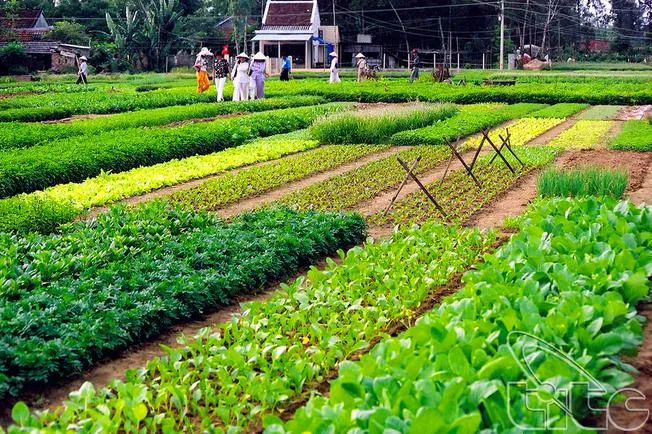
Journey to Discover Tra Que Vegetable Village
History of Formation and Development
Origin of the Name
Tra Que Vegetable Village is not only famous for its beauty and produce but also hides an interesting historical story about its name. Initially, the village was named Nhu Que, originating from the special aroma of the vegetables here, carrying a warm scent like cinnamon. In the 19th century, a special event changed the village’s name. Legend has it that King Gia Long, during a巡視 (inspection tour) of this land, visited the village and enjoyed dishes made from Nhu Que vegetables. The king was extremely impressed by the unique, delicate flavor and skillful vegetable growing techniques of the people. To commemorate this memorable experience, King Gia Long issued an edict changing the village’s name to Tra Que. Since then, the name Tra Que, meaning both elegant like tea and fragrant like cinnamon, has been associated with the village to this day, becoming an indispensable part of the local cultural identity.
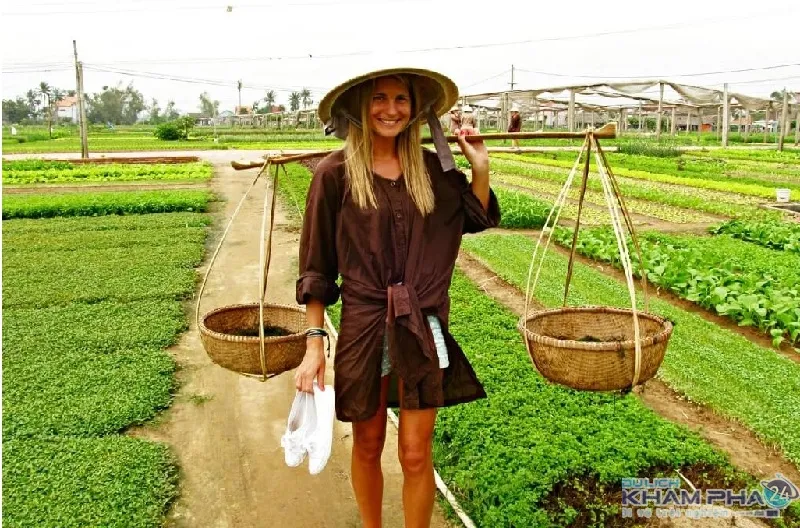
Honored as a National Intangible Cultural Heritage
April 4, 2023, marked an important historical milestone for Tra Que Vegetable Village when the village’s traditional vegetable growing profession was officially recognized by the Ministry of Culture, Sports and Tourism as a National Intangible Cultural Heritage. This noble title was awarded in the category of “Folk knowledge, traditional crafts”, affirming the cultural, historical, and unique values of the Tra Que vegetable growing profession. This is not only a great honor and pride for the community of vegetable farmers, but also a golden opportunity to spread values, promote the village brand, and attract domestic and international tourists. This event is of particular importance in the context of Hoi An’s efforts to restore and develop tourism after the impact of the pandemic, contributing to making Tra Que Vegetable Village a bright spot on the cultural tourism map of Vietnam.
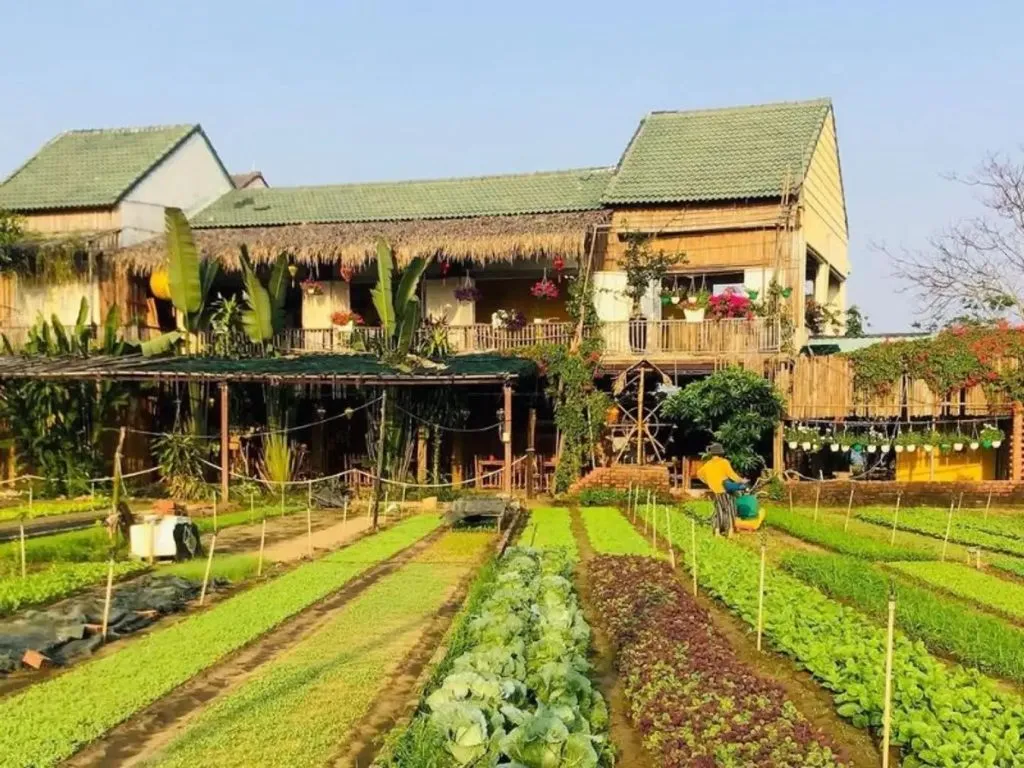
Unique Beauty of Tra Que Vegetable Village
Prime Geographical Location
Tra Que Vegetable Village boasts a very special geographical location, situated right next to the gentle Co Co River. This river not only provides abundant fresh water but also deposits fertile alluvium, creating ideal conditions for the growth of vegetables. Thanks to this favorable location, Tra Que vegetables are always green and fresh year-round. In addition, the vegetable village is only about 3km from the center of Hoi An ancient town and about 20km from Da Nang city, located on a major traffic route, very convenient for tourists to travel and visit. This prime location both helps the vegetable village maintain the peaceful, tranquil beauty of the countryside and easily connect with the bustling rhythm of urban life, creating a special attraction for tourists.
Diverse and Abundant Vegetable Gardens
Stepping into Tra Que Vegetable Village, visitors will be amazed by the diversity of green vegetables. On an area of over 40 hectares, local people cultivate more than 20 different types of vegetables, from familiar leafy vegetables such as mustard greens, water spinach, lettuce, to typical herbs such as basil, perilla, onions, coriander, mint, cilantro, peppermint… Each type of vegetable has its own flavor and color, creating a lively and colorful vegetable garden picture full of aroma. This diversity not only meets the diverse culinary needs of local people and tourists but also reflects the richness and diversity of the agricultural ecosystem here.
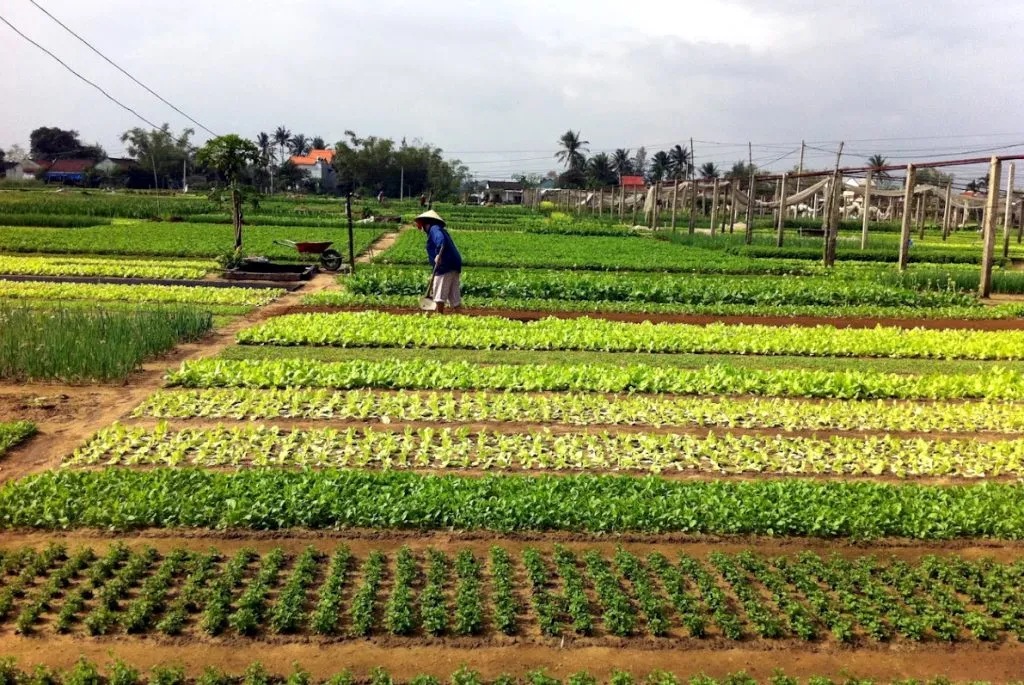
Unique Organic Farming Method
What makes the difference and fame of Tra Que vegetables is the unique traditional organic farming method. Local people do not use chemical fertilizers or pesticides but rely entirely on natural fertilizers, especially seaweed collected from the Co Co River. Seaweed, after being processed, becomes a valuable source of nutrients, helping vegetables grow green and healthy, with a distinctive flavor that cannot be found anywhere else. The closed, meticulous vegetable growing process, from seed selection, soil preparation, fertilization, watering, care to harvesting, is carried out using manual, traditional methods. As a result, Tra Que vegetables are not only fresh and delicious, safe for consumers’ health, but also environmentally friendly, contributing to the conservation of the natural ecosystem of Hoi An.
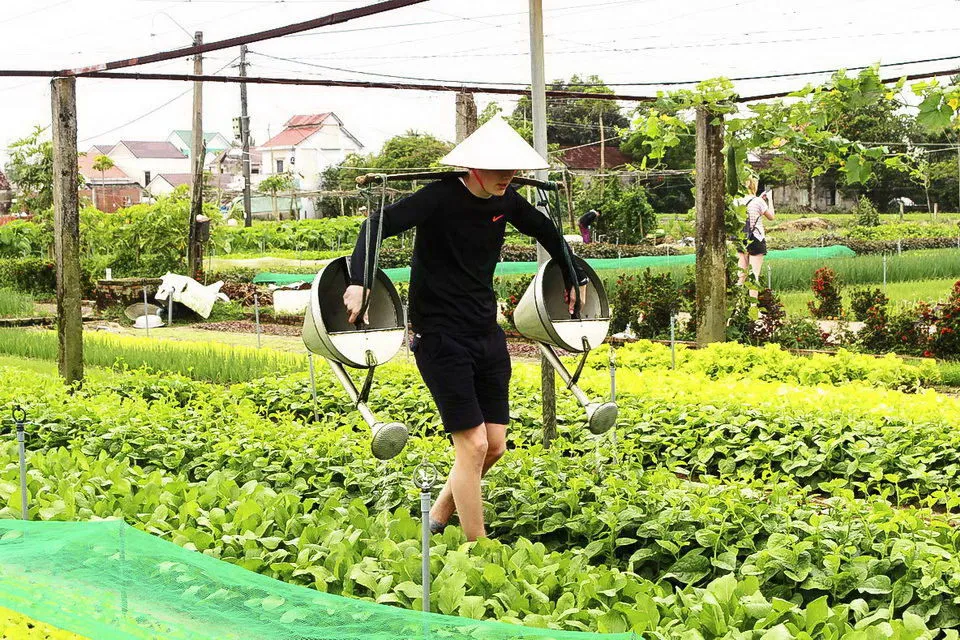
Real Experiences at Tra Que Vegetable Village
Morning: Immerse Yourself in Nature and Explore History
8:00 – 9:00 AM: Start Your Day at the Vegetable Village
To fully appreciate the beauty of Tra Que Vegetable Village, the ideal time to start your journey is early morning. When the dawn breaks, the vegetable beds still dotted with morning dew become fresh and full of life. The fresh air, the chirping of birds, and the peaceful scenery of the countryside will bring you a feeling of relaxation and comfort, dispelling all the fatigue and stress of everyday life.
9:00 – 10:30 AM: Visit Historical Sites and Learn About Culture
With a sightseeing ticket of only 35,000 VND, you will have the opportunity to explore historical sites imbued with the cultural imprint of Tra Que Village.
- Tomb of Mr. Nguyen Dien: Visit the tomb of Mr. Nguyen Dien, a virtuous and talented mandarin who made many contributions to the Nguyen Dynasty under the reign of three kings: Minh Mang, Thieu Tri, and Tu Duc. This place is not only a historical relic but also a spiritual destination, expressing the gratitude and admiration of the people for their predecessors.
- Tra Que Stone Well: Admire Tra Que Stone Well, an ancient architectural work built from the Cham Pa period. This stone well is not only a valuable source of domestic water for the people throughout history but also a testament to the long-standing existence and development of Tra Que Vegetable Village.
10:30 AM – 12:00 PM: Observe and Learn About the Cultivation Process
Spend time directly observing the unique vegetable growing process of Tra Que people. You will witness firsthand the stages of soil preparation, seaweed fertilization, sowing, watering, and vegetable care. Local people are always willing to share their experiences and secrets of traditional vegetable growing, helping you better understand the meticulousness, dedication, and love they have for farming.
Lunch: Experience Being a Farmer and Enjoy Cuisine
12:00 – 1:30 PM: Enjoy a Local Lunch
After a morning of exploration, stop at a local restaurant and enjoy lunch with specialties made from fresh Tra Que vegetables. Don’t miss the famous Tam Huu dish, chicken salad, or refreshing spring rolls, all imbued with the unique flavors of this land.
1:30 – 3:30 PM: Experience “A Day as a Farmer”
Participate in the “A Day as a Tra Que Farmer” tour to have real and exciting experiences. You will transform into a real farmer, performing farm work yourself such as:
- Carrying seaweed: Join the locals in carrying heavy loads of seaweed from the river to fertilize the vegetables.
- Soil preparation and watering: Learn how to loosen the soil and water the vegetables with a coconut shell ladle, a familiar image of the Vietnamese countryside.
- Harvesting vegetables: Harvest bunches of fresh, green vegetables from the garden with your own hands.
These activities not only bring joy and excitement but also help you deeply understand the hard but meaningful work of farmers, and appreciate the gifts that nature bestows.
Afternoon: Cooking Class and Enjoying Sunset
3:30 – 5:00 PM: Join a Cooking Class
If you love cuisine and want to discover the secrets of preparing delicious dishes from Tra Que vegetables, join a short cooking class. Under the enthusiastic guidance of local chefs, you will learn how to prepare Quang Nam specialties such as Tam Huu, Mi Quang, Cao Lau… and enjoy the results you create yourself.
5:00 – 6:00 PM: Relax and Watch the Sunset Over the Vegetable Fields
End a memorable day of experience at Tra Que Vegetable Village by relaxing among the green vegetable beds, watching the beautiful sunset dyeing the entire field in gold. Enjoying a cool glass of Tra Que sweet basil seed drink, feeling the peace and tranquility of the countryside, will surely be an unforgettable memory in your journey to explore Hoi An.
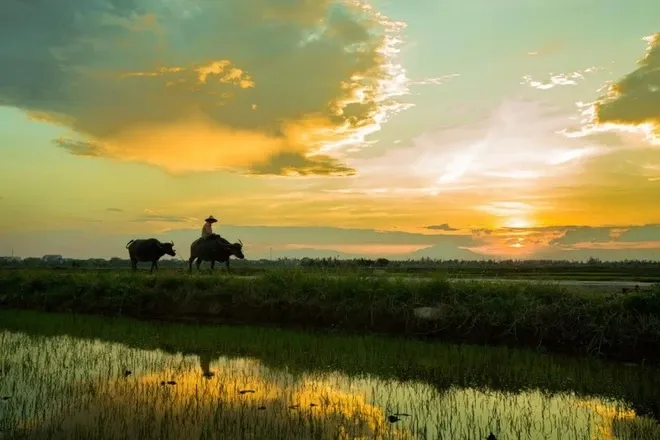
Unique Cuisine from Tra Que Vegetable Village
Tam Huu – The Quintessence of Flavor
Tam Huu is a famous dish, a culinary symbol of Tra Que Vegetable Village that any visitor should not miss. This dish is a delicate combination of three main ingredients, carrying deep symbolic meaning:
- Shrimp: Represents aquatic products, symbolizing the richness of rivers.
- Pork: Represents terrestrial products, symbolizing the abundance of land.
- Tra Que Vegetables: The soul of the dish, a precious product that makes the village famous, symbolizing identity and cultural tradition.
When enjoying Tam Huu, you will feel the wonderful harmony between the natural sweetness of shrimp and pork, the fresh and pure taste of Tra Que vegetables, along with a rich, characteristic dipping sauce. All create a unique, unforgettable flavor, expressing the attachment and gratitude of people to the land and rivers here.
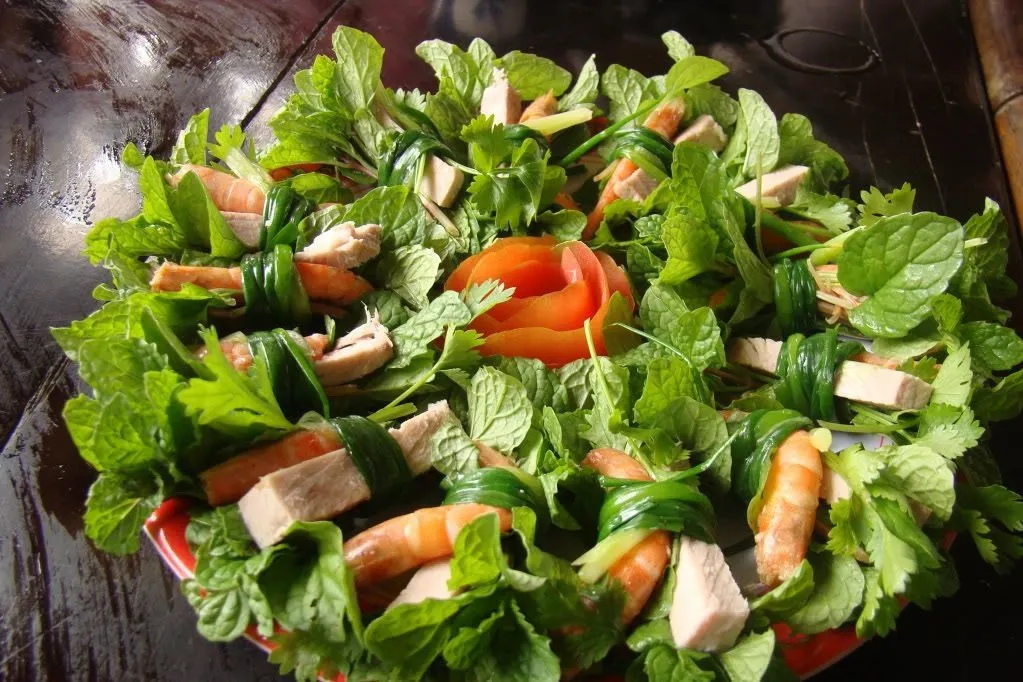
Mi Quang Tra Que – The Perfect Combination
Mi Quang, a famous specialty of Quang Nam, when combined with fresh, super clean raw vegetables from Tra Que Vegetable Village, will bring a completely new and attractive culinary experience. Golden, chewy noodles, rich and fragrant broth, flavorful braised chicken or shrimp, greasy quail eggs, crispy roasted peanuts, all blended with the fresh, pure taste of Tra Que vegetables, creating a well-rounded, irresistible dish. Mi Quang Tra Que is not only a delicious dish but also a culinary artwork, showing the sophistication and creativity in the way local people combine ingredients and flavors.

Tra Que Salad and Goi (Vietnamese Salad) – Refreshing and Nutritious
With a source of fresh, diverse, and abundant vegetables, Tra Que Vegetable Village is a paradise for salads and Goi (Vietnamese salads). These dishes are not only refreshing and cooling but also very nutritious and good for health. You can enjoy Tra Que chicken Goi, fresh spring rolls with shrimp, pork and raw vegetables, pennywort salad with beef, purslane salad… Each Goi and salad has its own flavor, but all have in common the freshness, crispness, and sweetness of Tra Que vegetables, harmoniously combined with other ingredients, creating attractive, unforgettable dishes.
Tra Que Vegetable Village Travel Guide
Ideal Time and How to Get There
- Best time to visit: The best time to visit Tra Que Vegetable Village is during the dry season, from February to August. At this time, the weather is sunny and dry, with little rain, very favorable for outdoor sightseeing and experiential activities. Early morning or late afternoon is the best time to admire the scenery and feel the fresh air of the vegetable village.
- How to get there:
- Bicycle: Renting a bicycle in the center of Hoi An and cycling to Tra Que Vegetable Village is an interesting experience, helping you both exercise and enjoy the street scenery and immerse yourself in local life.
- Taxi/Motorbike Taxi: If you want to travel quickly and comfortably, taxi or motorbike taxi is a suitable choice.
- Tour: Book a Tra Que Vegetable Village tour to have a professional guide introduce you in detail to the history, culture, and vegetable growing process of the village, and participate in exciting experiential activities.
Important Notes When Visiting
- Clothing: Choose comfortable, cool, sweat-absorbent clothing suitable for the weather and outdoor activities. Bring a hat, sunglasses, and sunscreen to protect your skin from the sun.
- Footwear: Prioritize low, flat-soled shoes that are easy to walk and move around in, avoid wearing high heels or unsuitable footwear.
- Behavior: Maintain general hygiene, do not litter, do not pick vegetables, break branches, or damage the vegetable gardens. Respect local people, culture, and village customs.
- Photography: Ask permission from locals before taking pictures of them or their vegetable gardens.
- Shopping: If you want to buy vegetables or local products, ask for prices and bargain reasonably, support local craftspeople.
- Drinking water: Bring enough drinking water, especially on hot days, to avoid dehydration.
- Safety: Follow the instructions and regulations of the vegetable village, ensure safety for yourself and those around you.
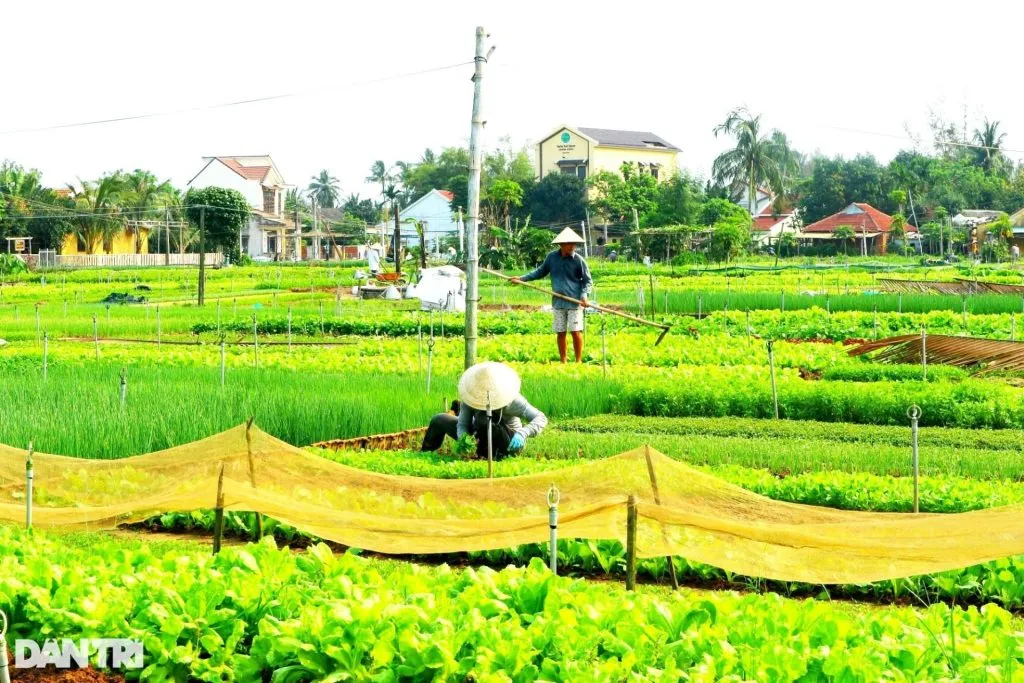
Accommodation Suggestions
To have a complete and comfortable visit to Tra Que Vegetable Village, choosing suitable accommodation is also very important. Hoiana Resort & Golf is a great suggestion, offering you a world-class luxury resort experience, harmoniously combining local cultural exploration and enjoying luxurious amenities.
- Convenient location: Hoiana Resort & Golf is located just about a 15-minute drive from Tra Que Vegetable Village, very convenient for traveling and visiting.
- World-class amenities: After a long day exploring the vegetable village, you can return to Hoiana and enjoy world-class amenities such as an infinity pool, relaxing spa, luxurious restaurants, vibrant casino, and beautiful golf course.
- Diverse experiences: Hoiana Resort & Golf is not only an ideal place to stay but also an attractive entertainment destination with many activities and special events.

Conclusion: Unmissable Experience in Hoi An
Tra Que Vegetable Village is not only a simple eco-tourism destination but also a living cultural heritage, preserving the precious traditional values of Hoi An. Coming to the vegetable village, visitors not only admire the peaceful beauty of the Vietnamese countryside, discover the unique vegetable growing process, but also experience exciting agricultural activities, enjoy unique cuisine, and learn about the history and culture of this land.
Experiencing Tra Que Vegetable Village will surely be a memorable memory in your journey to explore Hoi An. Take the time to visit this special village to fully feel the beauty and cultural values it brings, and don’t forget to choose Hoiana Resort & Golf as an ideal stopover to enjoy a perfect vacation, combining exploration and relaxation.
FAQ – Frequently Asked Questions
- What are the opening hours of Tra Que Vegetable Village? Tra Que Vegetable Village is open to visitors daily, from early morning to late afternoon. However, the busiest times are in the morning and late afternoon.
- What is the entrance fee to Tra Que Vegetable Village? The current entrance fee to Tra Que Vegetable Village is 35,000 VND per person. This ticket includes the entrance fee to historical sites in the village.
- Can I drive a motorbike to Tra Que Vegetable Village myself? Yes, you can absolutely drive a motorbike to Tra Que Vegetable Village yourself. The road is quite easy and there are clear signs.
- Is Tra Que Vegetable Village suitable for children to visit? Yes, Tra Que Vegetable Village is a very suitable destination for children. They can participate in farmer experience activities, learn about the vegetable growing process, and explore nature.
- Are there any vegetarian restaurants in Tra Que Vegetable Village? There are several vegetarian restaurants and eateries in and near Tra Que Vegetable Village, serving vegetarian dishes made from fresh vegetables from the village.
- Do I need to book a tour in advance to visit Tra Que Vegetable Village? Not required, but if you want to participate in experience tours such as “A Day as a Farmer” or cooking classes, it is recommended to book in advance to ensure availability and best service.
- Is there parking for cars at Tra Que Vegetable Village? Yes, Tra Que Vegetable Village has a car park for visitors. However, during peak tourist season, the parking lot may be overloaded.
- Where can I buy Tra Que vegetables after visiting? You can buy fresh vegetables directly at the gardens of farmers’ households, at agricultural product stores in the village, or at Hoi An market.